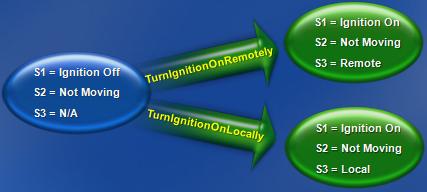Elements of MBT - Part 3 – Actions and Action Parameters
In the last 2 posts we have looked at what we mean by a model of a system and defined what States and State Variables are. In this post we'll look into Actions and Action Parameters.
We can define an Action as something that modifies or exercises the system. Thus "TurnIgnitionOn" (in the car model being used in this series) can be an action which causes the system to change in some way. When considering Actions you need to think about what exactly is it that changes in the system and which all state variables are impacted by those changes. An action is therefore simply something that causes the system to change states.
Actions become much more powerful and useful when combined with the concept of Action Parameters which can be considered to be similar to method parameters. Like a method (in a programming sense) does some work which can be tweaked or controlled by the method parameters, the effect of an Action can be affected by Action Parameters. In the car driving model an example of an Action Parameter would be whether the ignition could be turned on remotely (via the keychain) or locally. In that case we might want to add an Action Parameter to the model such as TurnIgnitionOn(Mode) where the "Mode" action parameter could take values "Remote" or "Local" similar to the way state variables can have different values.

A really interesting point that emerges here is that there is no one way to model the system. In the example above if for some reason you actually wanted to track how you had opened the car, maybe for a later stage in the model when you were actually locking the car then you would need to store this information in a state variable. Anytime you find yourself using the word "track" you should think about having that value as a state variable. We could therefore break our TurnIgnitionOn action into 2 different types of actions, TurnIgnitionOnRemotely and TurnIgnitionOnLocally and track how we opened the car as a new state variable, say S3, with values Remote or Local. Our model would therefore look something like this:

I will end this post with a word of caution. Even though it is quite easy to add a state variable to the model to track some aspect of the system, you should be very careful when adding state variables to your model and strive to minimize this number. The reason for this guidance is to limit the amount of state explosion that takes place as a result of defining these additional state variables. Remember that every time you define another state variable the number of possible states in the model is increasing exponentially. To keep your model manageable you should not add a state variable till it is absolutely critical to the behavior being captured.
UPDATE: Just noticed that this is actually my 100th post on this blog - WOW! Never thought I'd see the 100th post when I started out...it's been fun! :)